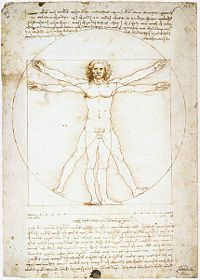Physiology
Physiology (Greek Φυσιολογία, physis, meaning "nature") can refer either to the parts or functions (mechanical, physical, and biochemical) of living organisms, or to the branch of biology that deals with the study of all the parts of living organisms and their various functions.
Since the function of a part is related to its structure, physiology naturally is related to anatomy, a term that can refer either to the internal structure and organization of an organism or any of its parts, or to the branch of biology that studies the internal structure and organization of living things.
Since the dawn of civilization, human beings have had a curiosity about nature and about the human body. In their efforts to better understand the mysteries of life, one key area is physiology. Most fields of biological endeavor—botany, zoology, embryology, cytology, etc.—include a study of function and thus of physiology. The science of medicine is particularly tied to the study of human physiology.
Physiology has traditionally been divided into plant physiology and animal physiology, but the principles of physiology are universal, no matter what particular organism is being studied. For example, what is learned about the physiology of yeast cells can also apply to human cells.
The field of animal physiology extends the tools and methods of human physiology to non-human animal species. Plant physiology borrows techniques from both fields. Physiology's scope of subjects is at least as diverse as the tree of life itself. Due to this diversity of subjects, research in animal physiology tends to concentrate on understanding how physiological traits changed throughout the history of animals.
Other major branches of scientific study with roots grounded in physiology research include biochemistry, biophysics, paleobiology, biomechanics, and pharmacology.
History
The history of physiology can be traced back at least as far as Greek natural philosophy. The study of anatomy, traced in history of anatomy reveals some of the early history of human physiology, as the study of human anatomy revealed functions as well.
In the eighth century C.E., it was Abu Bakr Al Razi (popularly known as Rhazes), a Persian physician and philosopher who described certain physiological parameters when he went to establish a hospital at Baghdad. Razi was followed by Al Kindi, who wrote a treatise on human physiology.
Anatomist William Harvey described blood circulation in the seventeenth century, providing the beginning of experimental physiology.
Herman Boerhaave is sometimes referred to as the father of physiology due to his exemplary teaching in Leiden and his textbook Institutiones medicae (1708).
In the United States, the first physiology professorship was founded in 1789 at the College of Philadelphia, and in 1832, Robert Dunglison published the first comprehensive work on the subject, Human Physiology (Encyclopedia of American History, 2007). In 1833, William Beaumont published a classic work on digestive function.
Among areas that have show significant growth in the twentieth century are endocrinology (study of function of hormones) and neurobiology (study of function of nerve cells and the nervous system).
Areas of physiology
Human and animal
Human physiology is the most complex area in physiology. This area has several subdivisions that overlap with each other. Many animals have similar anatomy to humans and share many of these areas.
- Myophysiology deals with the operation of muscles
- Neurophysiology concerns the physiology of brains and nerves
- Cell physiology addresses the functioning of individual cells
- Comparative or Environmental physiology examines how animals adapt to their environment
- Membrane physiology focuses on the exchange of molecules across the cell membrane
- Respiratory physiology describes the mechanics of gas exchange at the cellular level and also at a gross anatomic level within the lungs
- Circulation also known as cardiovascular physiology, deals with the heart, blood, and blood vessels and issues arising from any malfunction
- Renal physiology focuses on the excretion of ions and other metabolites at the kidney
- Endocrinology covers endocrine hormones which affect every cell in the body
- Neuroendocrinology concerns the complex interactions of the neurological and endocrinological systems which together regulate physiology
- Reproductive physiology concerns the reproductive cycle
- Exercise physiology addresses the mechanism and response of the body to movement
Plant
Plant physiology has differing subdivisions. For example, since plants do not have muscles and nerves, neither myophysiology nor neurophysiology applies.
- Transpiration is the study of water loss from the plant leaves.
- Photosynthesis is the conversion of sunlight energy, water and CO2 to form sugars (glucose).
ReferencesISBN links support NWE through referral fees
- Physiology. Answers.com, 2007. Retrieved February 10, 2007.
- Fye, B. W. 1987. The Development of American Physiology: Scientific Medicine in the Nineteenth Century. Baltimore: Johns Hopkins University Press.
- Rothschuh, K. E. 1973. History of Physiology. Huntington, N.Y.: Krieger.
External links
All links retrieved November 23, 2022.
| General subfields within Biology |
|---|
| Anatomy | Biochemistry | | Botany | Cell biology | Ecology | Developmental biology | Ethnobotany | Evolutionary biology | Genetics | Ichthyology | Limnology | Medicine | Marine biology | Human biology | Microbiology | Molecular biology | Origin of life | Paleobotany | Paleoclimatology | Paleontology | Parasitology | Pathology | Physiology | Taxonomy | Zoology |
Credits
New World Encyclopedia writers and editors rewrote and completed the Wikipedia article in accordance with New World Encyclopedia standards. This article abides by terms of the Creative Commons CC-by-sa 3.0 License (CC-by-sa), which may be used and disseminated with proper attribution. Credit is due under the terms of this license that can reference both the New World Encyclopedia contributors and the selfless volunteer contributors of the Wikimedia Foundation. To cite this article click here for a list of acceptable citing formats.The history of earlier contributions by wikipedians is accessible to researchers here:
The history of this article since it was imported to New World Encyclopedia:
Note: Some restrictions may apply to use of individual images which are separately licensed.
